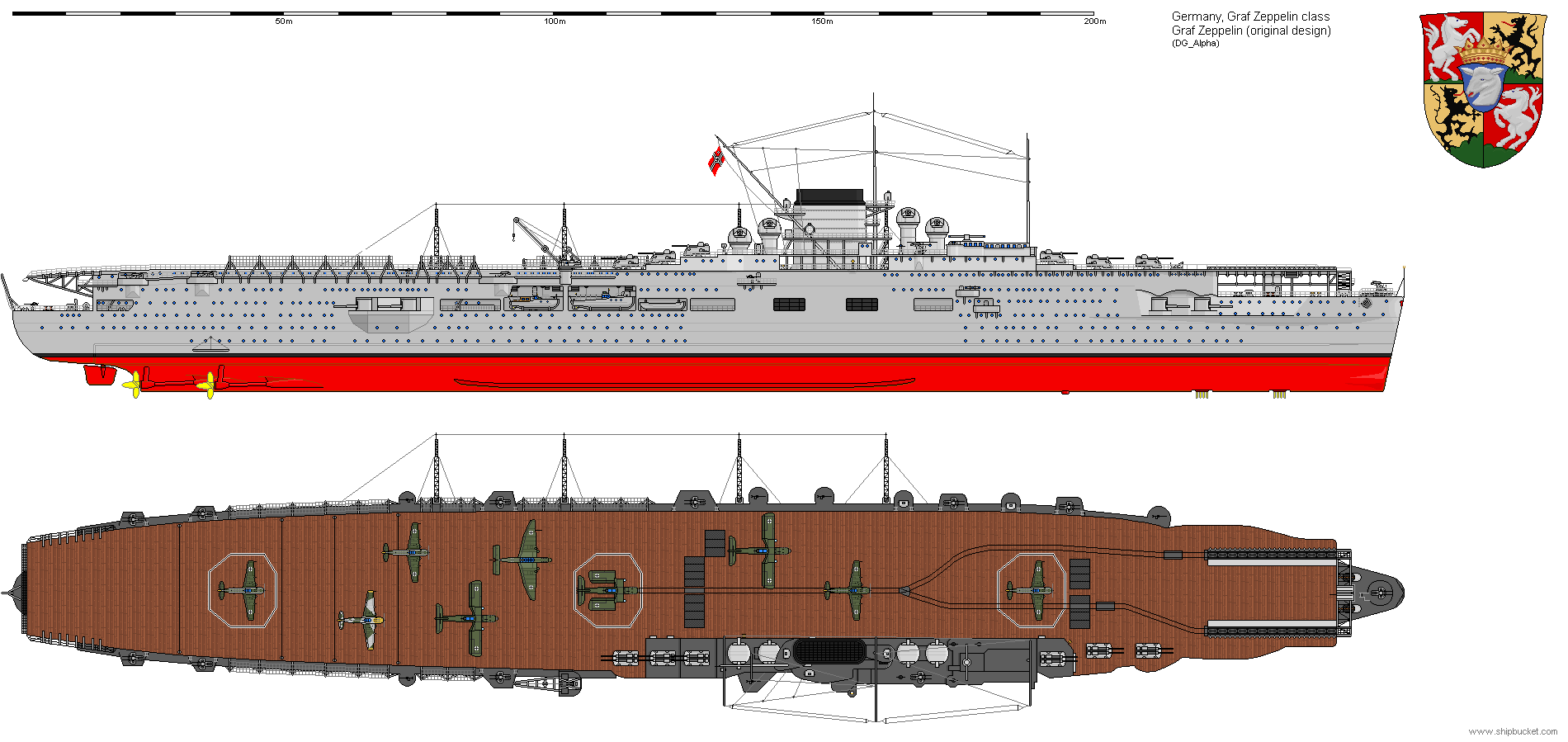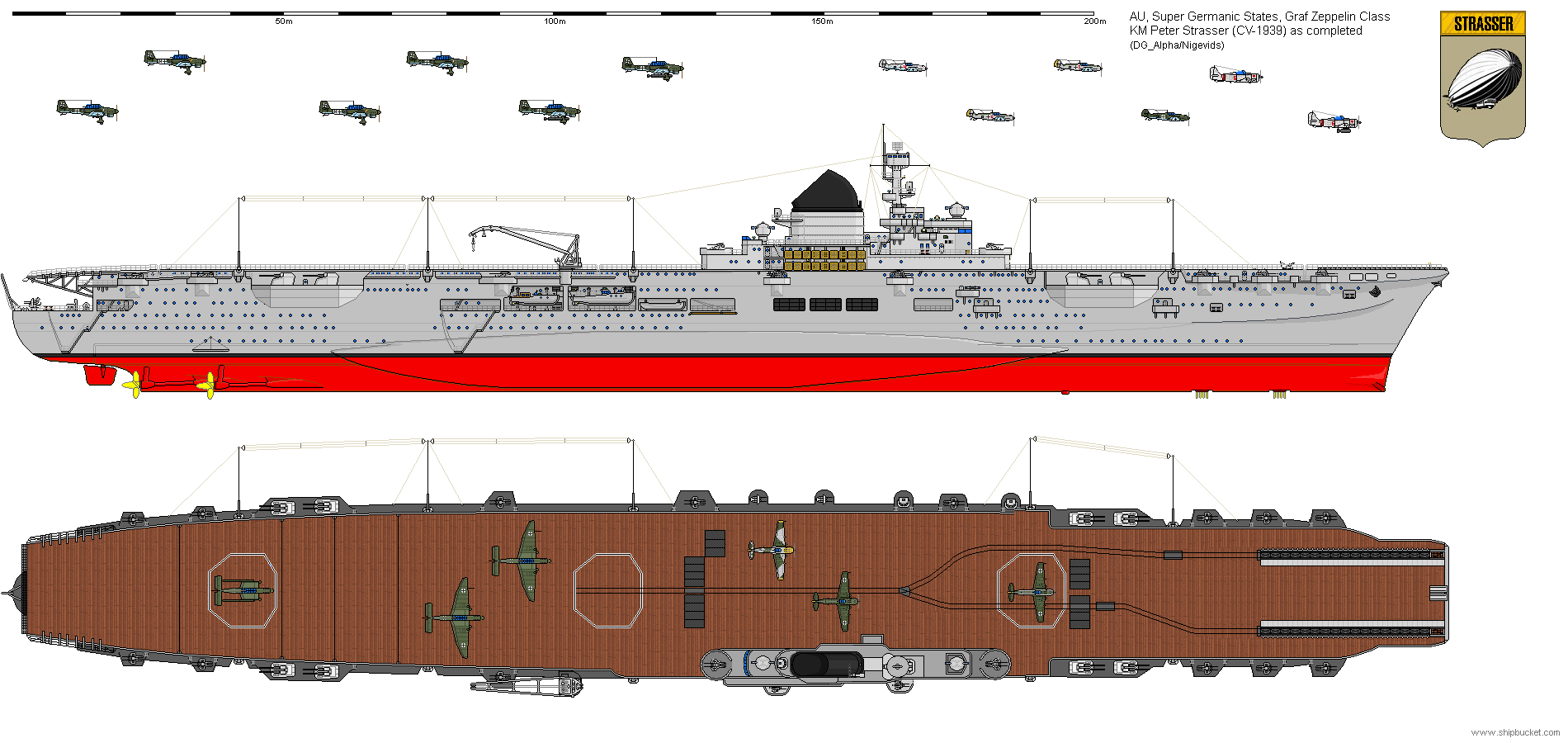KM Graf Zeppelin (CV-1938)
Back to Germanic States Navy
page:
The Graf Zeppelin came from the expiry of the Naval treaties that had
restricted the Germanic States in what they could build and how big it could be.
The Graf Zeppelin was the Germanic States first try at building an aircraft
carrier from the keel up, but their designers had not really taken in what was happening around
the world. The only other experience they had had so far with aircraft carriers had been
the ex-passenger liner conversion they had done for Argentina and the conversion
of the Anhalt-Dessau. The open front
flight deck configuration was quickly found to be of little use in heavy seas
on the Anhalt-Dessau and an enclosed bow section was fitted to the design for
the Graf Zeppelin during building. Removal of the casemate guns, reduce the
number of directors, and downsize the bridge structure. A little bit of
intelligence work would have noted that both the US, Japan and Great Britain,
were all reducing and removing all of the 5.5" to 8" guns that had been fitted
to their ships. To include single then twin 5.9" on the designs for the Graf
Zeppelin just made the ship look very antiquated and wasted a lot of space that
could have been better used to increase the aircraft complement, which was a bit
on the low size for such a large ship.

The open front flight deck configuration was quickly found to be of little use
in heavy seas on the Anhalt-Dessau and an enclosed bow section was fitted to the
design for the Graf Zeppelin during building. Removal of the casemate guns,
reduce the number of directors, and downsize the bridge structure. A little bit
of intelligence work would have noted that both the US, Japan and Great Britain,
were all reducing and removing all of the 5.5" to 8" guns that had been fitted
to their ships. To include single then twin 5.9" on the designs for the Graf
Zeppelin just made the ship look very antiquated and wasted a lot of space that
could have been better used to increase the aircraft complement, which was a bit
on the low size for such a large ship.
Peter Strasser under construction 1937.

The eventual final design that was built to, and various alterations that took
place during building added to a much better balanced aircraft carrier. Having
the Anhalt-Dessau to trial things on and the designers looking at what might
happen with some of their design elements, made some of it look very stupid.
Having the twin 4.1" only on the bridge structure meant that when the guns were
firing to port, across the flight deck, flying operations had to be suspended.
Where launching aircraft to deal with whatever the 4.1" were firing at might be
a better option. During the redesigning and building the heavy AA weaponry was
changed to the newer 88mm twin weapons mounted below flight deck level on both
sides of the ship.

The original aircraft complement with the Me-109 fighter was upgraded to the
FW-190 in 1940 with the 190's introduction. The Me-109 suffered the same fate as
the UK experienced with the Seafire. The narrow undercarriage made for many deck
landing accidents. The switch to the 190 gave the Navy a fighter that was
certainly in advance of any of its competitors carrier borne fighters at that
time. With an uprated engine from late 1941 the FW190 was even able to carry a
torpedo. Note the extra high tail wheel for clearance for the torpedo.

The 5.9" and bow are still to be replaced in this photo just after launching of
the Graf Zeppelin.
| Displacement |
34,500 tons std, 41,800 full load |
| Length |
870 ft |
| Breadth |
116 ft |
| Draught |
28 ft |
| Machinery |
4 shaft mixed turbine/diesel propulsion
2 x Steam Turbines 120,000shp
2 x Diesels 40,000bhp |
| Speed |
32 knots |
| Range |
12,500 miles at 18 knots |
| Armour |
3.9" side, 3.9" main deck, 1.5" Flight deck |
| Armament |
16 x 88mm (8x2)
32 x 37mm Bofors (16x2)
24 x 20mm (6x4) |
| Aircraft |
74 |
| Complement |
2350 |
| Notes |
KM Graf Zeppelin (1938)
KM Peter Strasser (1939) |

My upgrade of original with deck edge lift and enclosed bow, 5.9" removed -
first thing I do for all GZ drawings - complete waste of space.

Back to Germanic States Navy
page:


